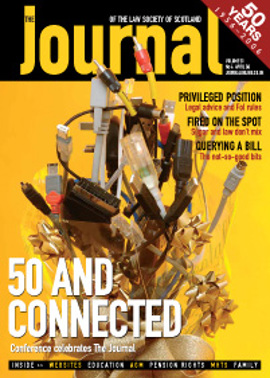Rushed law and wrongful death

Though sometimes unavoidable, it is never a good idea for new provisions to be added into legislation at late stages of the parliamentary process. This deprives the provision of the benefits of careful scrutiny by the appropriate committee, and by its adviser. Such scrutiny was denied a very late addition to the Family Law (Scotland) Act 2006, introduced as amendment 102 on the last day of the stage 2 debate (30 November 2005). Though the Scottish Law Commission’s proposals, upon which the amendment was based, had been widely consulted on, the precise wording of the amendment had not been (as the two Strathclyde LLB graduates on the Justice 1 Committee perceptively noted in the debate). In at least one respect, the words used will require imaginative judicial construction before it achieves its purpose.
Ill-fitting rules
The provision is section 35, which amends the Damages (Scotland) Act 1976 by removing some categories of relative from the list of “immediate family” in schedule 1 thereto, and adding some other categories. The stated purpose was to give effect to the recommendations of the Scottish Law Commission in their Report on Title to Sue for Non-Patrimonial Loss (Scot Law Com no 187). Title to sue for such loss under the 1976 Act is a matter of no little social significance, because its granting provides legal recognition that the relationship between a deceased and a survivor is worthy of respect and protection. When the 1976 Act was originally passed, only spouses, parents, children and those accepted as children of the family were recognised. In 1982 title to sue was extended to couples who were not married to each other but who lived together as if they were husband and wife – an important recognition that the social relationship was legitimate and worthy of the law’s protection, that the emotional distress at losing a (heterosexual) partner was likely to be as severe (and as legitimately felt) as such distress at losing a spouse.
However, it had long been felt that the existing rules were too narrow in some respects while at the same time were too broad in others. In particular, the rule that allowed relatives by affinity to sue on the same basis as relatives by consanguinity was considered to be unduly generous. There was a feeling that a mother’s loss is of a different order from that of a mother-in-law. Yet Mrs Monteith was allowed to sue for her son-in-law’s death on the same basis as his own mother: Monteith v Cape Insulation 1998 SC 903. At the same time, the Scottish Law Commission believed that the exclusion of siblings and of grandparents was not justified, and that the limitation of cohabitants to opposite-sex couples (see Telfer v Kellock 2004 SLT 1290) was out of step with the modern acceptance of the legitimacy of same-sex couples, and of their unanswerable demands for equality.
The closer immediate family
Section 35 addresses all these issues, other than same-sex cohabitation. There had been an attempt to deal with that particular issue in the Civil Partnership Act 2004, though in the event the attempt failed since the amendment to the 1976 Act in paragraph 42 of schedule 28 to the 2004 Act referred to the wrong subparagraph in schedule 1 to the 1976 Act. One may doubt whether that would have happened if this central element of devolved law had been dealt with by the devolved legislature. Be that as it may, paragraph 2 of schedule 2 to the Family Law (Scotland) Act 2006 corrects the error and treats same-sex cohabitants in the same way as opposite-sex cohabitants.
The uncontentious provisions are in section 35(5), which adds four new categories to the list of “relatives” who count as “immediate family” for the purposes of the 1976 Act and who therefore are entitled to sue for non-patrimonial loss. First, siblings. This finally fills a gap identified by the court in McKendrick v Sinclair 1972 SC(HL) 25. The judicial call in that case for a statutory amendment to bring in siblings was ignored by the Parliament that passed the 1976 Act, but has been heeded here. Secondly, grandparents and grandchildren (but no further in the ascending or descending line). Thirdly, persons who accepted the deceased as a child of their family. This removes an anomaly in the present law: a child accepted by the deceased as a member of his or her family can sue on the death of the deceased, but the accepting adult could not sue on the death of the child. Now the accepting adult can. And fourthly, persons who were brought up in the same household as the deceased and who were accepted as a child of the family in which the deceased was a child: this includes children who are not siblings of the deceased but were brought up as if they were.
The concept of children “accepted as a child of the family” is retained, and indeed extended by the fourth category just mentioned. The Scottish Law Commission had recommended that this was a more appropriate indicator of title to sue than the status-based indicator of affinitive relationship, bearing in mind that there will be a substantial overlap. A step-parent may accept a child as a child of his or her family, or he or she may not, or the child may be an adult by the time the step-relationship is created. Entitlement to sue under the 1976 Act is presently based on the step-relationship itself (a relationship of affinity), but section 35(5) provides that in the future entitlement to sue will be based on the act of acceptance.
Affinity as a bar
So far so good. The problem comes with section 35(3), which is designed to remove affinity as the indicator of entitlement. In its own terms (which were not those suggested by the Scottish Law Commission) it is far too broad. It adds a new section 1(4A) to the 1976 Act in the following terms “Notwithstanding section 10(2) of, and Schedule 1 to, this Act, no award of damages under subsection (4) above shall be made to a person related by affinity to the deceased.” In its literal sense, this provision means that even although a person comes in the list in schedule 1, as for example being an accepted child, they are knocked out of that list if their relationship with the deceased is one of affinity.
This is not what was intended. The removal of affinity was supposed to be the removal of an indicator of entitlement, but the words used convert affinity into a positive – and absolute – bar. This interpretation must be avoided. If the new section 1(4A) is given its literal meaning, the result would be that cohabitants who accept each other’s children as children of the family would have a claim in circumstances in which spouses and civil partners who do so would not – because marriage and civil partnership create relationships of affinity (a new section 1(4B) spells this out in case there was any doubt), but cohabitation does not.
Not only is it highly unlikely to have been the parliament’s intention to preference cohabitants over spouses but this literal interpretation of the new section 1(4A) satisfies no legitimate aim. It might well be contrary to articles 8 and 14 of the ECHR to give cohabitants a claim for damages in circumstances in which spouses have no such claim, when the loss to each is identical. If this is so, then it becomes legitimate, even necessary, to read in words to the provision to remove the discrimination and give effect to what the Parliament can be taken to have intended. I suggest the following words, in square brackets, should be read in: “(4A) Notwithstanding section 10(2) of, and Schedule 1 to, this Act, no award of damages under subsection (4) above shall be made to a person [solely on the basis that he or she is] related by affinity to the deceased.” There is no doubt that this changes the sense of the subsection, but nor is there any doubt (in my view) that it better reflects what was always intended.
Modesty? The very idea
I notice, finally, in the February Journal’s letters page that a correspondent suggested that I had hidden my own light under a bushel in my January column, by not revealing that I had been Justice 1’s adviser during the passage of the 2006 Act. I have been accused of many things over the years, but never before of modesty. Let me redress matters with this assertion: had the amendment now contained in section 35 been laid at an earlier stage, Justice 1 would have been properly advised and the wording would have been altered before enactment. And the fact that it was the law graduates on Justice 1 who expressed discomfort at being asked to enact words they had only just been presented with goes a long way to subvert the claim, also in February’s Journal, that a law degree no longer makes good lawyers.
Kenneth McK Norrie, University of Strathclyde
In this issue
- Bias and mental health tribunals: a reply
- Legal science or law-lite? A response (1)
- Opening a binding global route for personal data
- Mentally disordered offenders
- Change but not for the sake of it
- Legal science or law-lite? A response
- On message
- A bill to query
- Client confidentiality and freedom of information
- Rushed law and wrongful death
- Qualifying by degrees
- Safeguards before the MHTs
- The treatment of pension rights on divorce
- We've paid for it: what do you mean it's not ours?
- Communication: the #1 risk management tool?
- Sugar but not sweet
- AGM report
- Guidance on guidelines
- The licensed trade: going up in smoke?
- Clause for concern
- Fully charged
- Scottish Solicitors' Discipline Tribunal
- Website reviews
- Book reviews
- New CAR drives discharge regime






